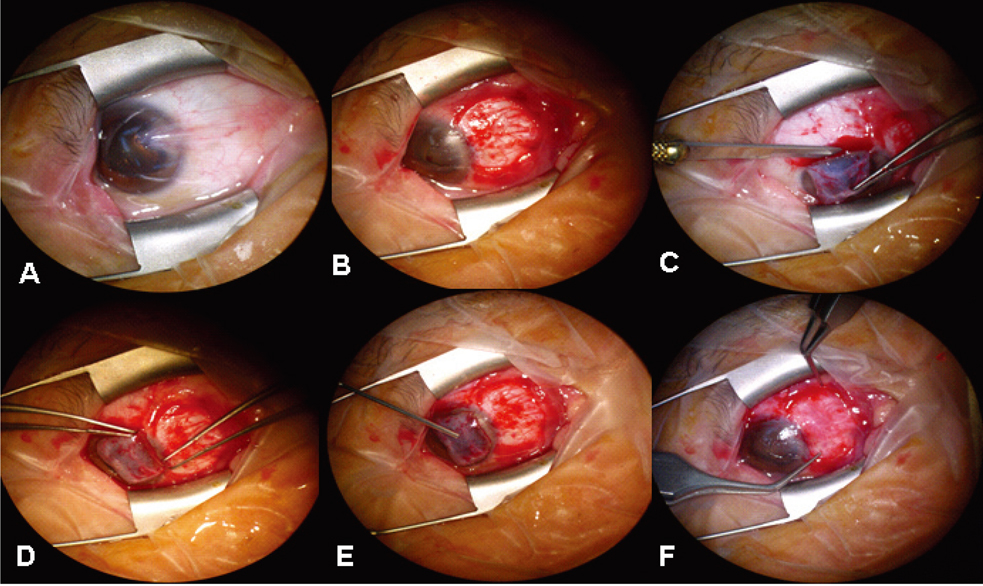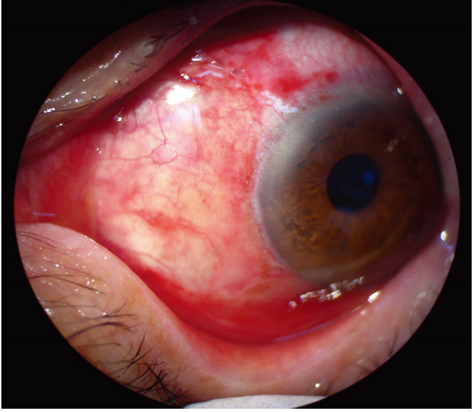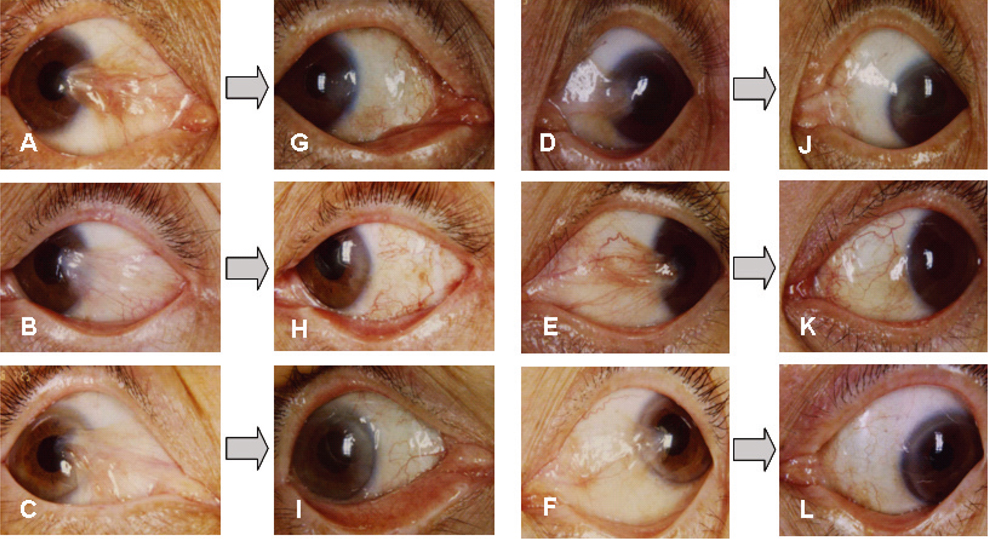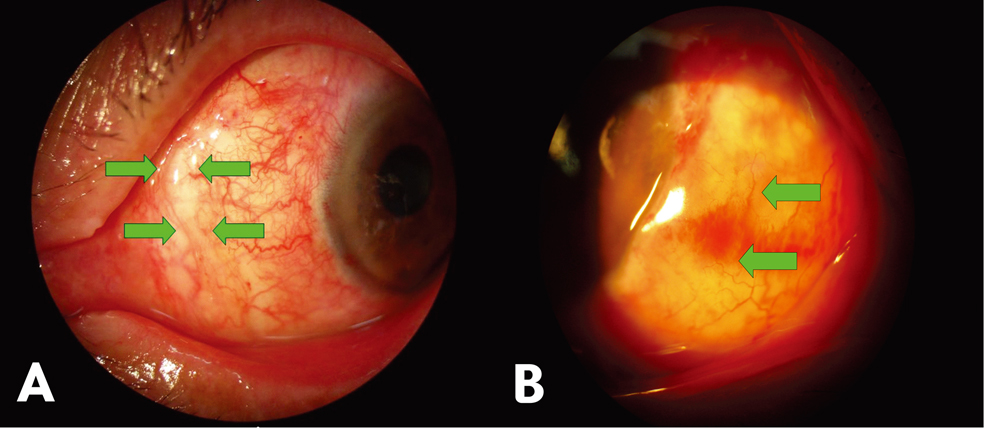Conjunctivolimbal Autograft Using a Fibrin Adhesive in Pterygium Surgery
- Affiliations
-
- 1Department of Ophthalmology, Cheil Eye Hospital, Daegu, Korea. eyepark9@dreamwiz.com
- 2Department of Ophthalmology, Kyungpook National University College of Medicine, Daegu, Korea.
- KMID: 1070748
- DOI: http://doi.org/10.3341/kjo.2008.22.3.147
Abstract
- PURPOSE: To evaluate the efficacy and safety of fibrin bioadhesive in conjunctivolimbal autograft surgery for primary pterygium. METHODS: Thirty-six eyes in 34 patients were reviewed with nasal primary pterygium who were treated with pterygium excision with superior conjunctivolimbal transplantation with fibrin bioadhesive. Surgical durations were recorded and the patients were followed up on the first day after surgery and then at 1, 2, 4, 8 and 12 weeks postoperatively. The graft-recipient site attachments were examined and subjective symptoms of patients were recorded at every follow-up examinations. RESULTS: The mean patient age was 57.9+/-10.1 (ranging from 33 to 83) years. The mean follow-up period was 22.05+/-5.78 weeks. The mean surgery time was 18.04+/-5.65 minutes. The subjective symptoms (pain, foreign body sensation, tearing and discomfort) disappeared in 23 of 36 eyes (64%) in one week after surgery, and all discomforts subsided within two weeks after surgery in all patients. The conjunctivolimbal autograft was correctly positioned and fixed in 34 of 36 eyes (94.4%) throughout the follow-up period. Graft dehiscence was seen in two eyes (5.6%), one eye was treated with remedial sutures, and the other eye showed a spontaneous healing without remedial sutures. Transient graft edema occurred in four eyes (11.2%) but subsided spontaneously within a month. There were no cases of pterygium regrowth or complications due to the fibrin bioadhesive. CONCLUSIONS: The use of fibrin bioadhesive in conjunctivolimbal autograft surgery in primary pterygium simplifies surgical techniques, shorten surgical duration, and produce less postoperative subjective symptoms . Therefore, the fibrin bioadhesive is a safe and effective tool to attach conjunctivolimbal autograft in primary pterygium surgery.
MeSH Terms
Figure
Cited by 4 articles
-
Clinical Research on Surgical Treatment for Double-Head Pterygium
Byeong Hee Lee, Gwang Ja Lee, Young Jeung Park, Kyoo Won Lee
J Korean Ophthalmol Soc. 2010;51(5):642-650. doi: 10.3341/jkos.2010.51.5.642.The Effect of Subconjunctival Bevacizumab Injection before Conjunctival Autograft for Pterygium
Yong Il Kim, Geun Young Lee, Eun Joo Kim, Yeoun Hee Kim, Kyoo Won Lee, Young Jeung Park
J Korean Ophthalmol Soc. 2015;56(6):847-855. doi: 10.3341/jkos.2015.56.6.847.Clinical Outcomes after Use of Fibrin Glue Using a Modified Mini-flap Technique for Pterygium Surgery
Moon Kyoung Kim, Ikhyun Jun, Tae-im Kim, Eung Kweon Kim, Kyoung Yul Seo
J Korean Ophthalmol Soc. 2017;58(7):797-803. doi: 10.3341/jkos.2017.58.7.797.Clinical Research on Effectiveness of Mitomycin C on Primary Pterygium With Limbal-Conjunctival Autograft
Byeong Hee Lee, Jong Wook Lee, Young Jeung Park, Kyoo Won Lee
J Korean Ophthalmol Soc. 2009;50(7):996-1004. doi: 10.3341/jkos.2009.50.7.996.
Reference
-
1. Lee SH, Jeong HJ. Immune reactions in pterygium. J Korean Ophthalmol Soc. 1987. 28:933–937.2. Allan BDS, Short P, Crawford GJ, et al. Pinguecula and pterygia. Surv Ophthalmol. 1988. 33:41–49.3. Amano S, Motoyama Y, Oshika T, et al. Comparative study of intraoperative mitomycin C and beta irradiation in pterygium surgery. Br J Ophthalmol. 2000. 84:618–621.4. Talu H, Tasindi E, Ciftci F, Yildiz TF. Excimer laser phototherapeutic keratectomy for recurrent pterygium. J Cataract Refract Surg. 1998. 24:1326–1332.5. Na KS, Kim JY, Choi GJ. A clinical observation on the argon laser effect of the pterygium. J Korean Ophthalmol Soc. 1996. 37:1120–1125.6. Joselson GA, Muller VP. Incidence of pterygium recurrence in patients treated with Thio-tepa. Am J Ophthalmol. 1966. 81:891–895.7. Panda A, Gopal KD, Suhas W, et al. Randomized trial of intaoperative mitomycin C in surgery for pterygium. Am J Ophthalmol. 1998. 125:59–63.8. Rubinfeld RS, Pfister RR, Stein RM, et al. Serious complications of topical mitomycin-C after pterygium surgery. Ophthalmology. 1992. 99:1647–1654.9. Ma DH, See LC, Liau SB, Tsai RJ. Aminotic membrane graft for primary pterygium: comparision with conjunctival autograft and topical mitomycin C treatment. Br J Ophthalmol. 2000. 84:973–978.10. Sanchez-Thorin JC, Rocha G, Yelin JB. Meta-analysis on the recurrence rates after bare sclera resection with and without mitomycin C use and conjunctival autograft placement in surgery for primary pterygium. Br J Ophthalmol. 1998. 82:661–665.11. Tan DT, Chee SP, Dear KB, Lim AS. Effect of pterygium morphology on pterygium recurrence in a contolled trial comparing conjunctival autografting with bare sclera excision. Arch Ophthalmol. 1997. 115:1235–1240.12. Lagoutte FM, Gauthier L, Comte PR. A fibrin sealant for perforated and preperforated corneal ulcers. Br J Ophthalmol. 1989. 73:757–761.13. Mandel MA. Closure of blepharoplasty incisions with autologous fibrin glue. Arch Ophthalmol. 1990. 108:842–844.14. Kajiwara K. Repair of a leaking bleb with fibrin glue. Am J Ophthalmol. 1990. 109:599–601.15. Kaufman HE, Insler MS, Ibrahim-Elzembely HA, Kaufman SC. Human fibrin tissue adhesive for sutureless lamellar keratoplasty and scleral patch adhesion: a pilot study. Ophthalmology. 2003. 110:2168–2172.16. Cohen RA, McDonald MB. Fixation of conjunctival autografts with an organic tissue adhesive. Arch Ophthalmol. 1993. 111:1167–1168.17. Koranyi G, Seregard S, Kopp ED. Cut and paste: a no suture, small incision approach to pterygium surgery. Br J Ophthalmol. 2004. 88:911–914.18. Harvey SU, Reyes JM, Flore JD, Lim-Bon-Siong R. Comparison of fibrin glue and sutures for attaching conjunctival autografts after pterygium excision. Ophthalmology. 2005. 112:667–671.19. Kim JC, Lee DH, Shyn KH. Clinical use of human amniotic membrane for ocular surface diseases. Advances in Corneal Research. 1997. 117–134.20. Sridhar MS, Bansal AK, Rao GN. Surgically induced necrotizing scleritis after pterygium excision and conjunctival autograft. Cornea. 2002. 21:305–307.21. Ti SE, Chee SP, Dear KB, Tan DT. Analysis of variation in success rates in conjunctival autografting for primary and recurrent pterygium. Br J Ophthalmol. 2000. 84:385–389.22. Kim YS, Kim JH, Byun YJ. Limbal-conjunctival autograft transplantation for the treatment of primary pterygium. J Korean Ophthalmol Soc. 1999. 40:1804–1810.23. Guler M, Sobaci G, Liker S, et al. Limbal-conjunctival autograft transplantation in cases with recurrent pterygium. Acta Ophthalmologica. 1994. 72:721–726.24. Polute P, Heilinggenhaus A, Koch J, Steuhl KP. Long-term results of autologous conjunctival-limbus transplantation in pterygium. Klin Monatsbl Augenheilkd. 1998. 213:9–14.25. Ahn DG, Auh SJ, Choi YS. The clinical results of limbal conjunctival transplantation with intraoperative mitomycin C application for recurrent pterygium. J Korean Ophthalmol Soc. 1999. 40:2443–2449.26. Park JM, Ahn HB, Park WC. The effect of combined amniotic membrane and limbal transplantation for recurrent pterygium or pseudopterygium. J Korean Ophthalmol Soc. 2003. 44:1504–1511.27. Oh TH, Choi GY, Yoon BJ. The effect of conjunctival autograft for recurrent pteygium. J Korean Ophthalmol Soc. 1994. 35:1335–1339.28. Van Herendael BJ, Oberti C, Brosens I. Microanatomy of the human amniotic membrane: a light microscopic, transmission, and scanning microscopic study. Am J Obstet Gynecol. 1978. 131:872–880.29. Terranova VP, Lyall RM. Chemotaxis of human gingival epithelial cells to laminin: a mechanism for epithelial cell apical migration. J Periodontol. 1986. 57:311–317.30. Na BK, Hwang JH, Kim JC, et al. Analysis of human amniotic membrane components as proteinase inhibitors for development of therapeutic agent for recalcitrant keratitis. Tropho Res. 1999. 13:453–466.31. Kim MJ, Tchah HW. Treatment of pterygium with amniotic membrane transplantation. J Korean Ophthalmol Soc. 1998. 39:59–64.
- Full Text Links
- Actions
-
Cited
- CITED
-
- Close
- Share
- Similar articles
-
- Recurrence Rates of Amniotic Membrane Transplantation, Conjunctival Autograft and Conjunctivolimbal Autograft in Primary Pterygium
- Clinical Outcomes between Amniotic Membrane Transplantation and Conjunctival Autograft Using Fibrin Glue for Pterygium Surgery
- Scleral Graft, Free Conjunctival Autograft Using Tissue Adhesive and Temporary Amniotic Membrane Transplantation in Scleromalacia
- Superior-inferior Sliding Conjunctival Flap for Pterygium with a Fibrin Tissue Adhesive (Tisseel(R))
- The Use of Fibrin Glue for Conjunctival Autotransplantation in Pterygium





